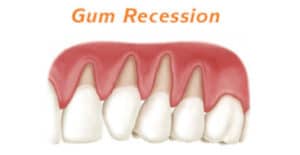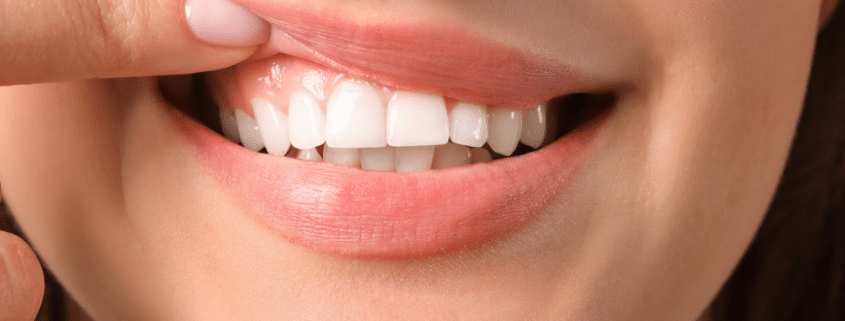What is Gum Recession and How Can it be Treated?
Receding gums is a very common condition that can affect individuals no matter their level of oral health. The truth is many people don’t even realize they have the beginning stages of gum recession until they visit their dentist and have a proper exam. If not diagnosed and treated can lead to other painful problems. However, if caught early, treatment can be simple.
So the big questions are….
What is Gum Recession?
It is when the gum around your teeth lessens, pulls back and away from your teeth exposing more of the tooth and over time can even expose most of the root of the tooth. When this occurs pockets can form in between teeth giving more space for bacteria to have a party. If left untreated can further lead to more serious gum disease issues and even tooth loss. Here I will outline what causes this condition and how best to treat it.

What are the Causes of Gum Recession?
1) Aggressive Tooth Brushing
I am thrilled that you love to brush and care for your teeth! However you may need to take it down a notch and be more gentle with your approach. Being aggressive with the toothbrush can sometimes be just as bad as someone who is not consistent with their oral hygiene. Aggressive tooth brushing can force the gums down and away from your teeth causing gum recession. Teeth need gentle brushing not harsh scrubbing. Sonicare has introduced a new electric toothbrush that now has a pressure sensor that detects if you are applying too much pressure while brushing. I love this new feature!!
This Sonicare tooth brush lights up to indicate that you are applying too much pressure while brushing
2) Poor Oral Hygiene / Health
Have you been putting off visiting the dentist? Are you not consistent with brushing and flossing? If you answered yes to either or both of these questions then you are at a higher risk of developing gum recession. Not taking care of your teeth can cause a build up of tartar which is a major player in developing gum recession. As I mentioned in my New Year’s resolution blog, it is best to make a habit of brushing twice a day for 2 minutes each, floss gently between teeth (stay tuned for a blog and video about how to floss properly coming soon) and rinse your mouth with an antibacterial mouth wash. You will not only help prevent gum recession and disease, but your mouth will feels so fresh and clean.
3) Periodontal Disease
According the Canadian Dental Association seven out of 10 Canadians will develop gum disease at some time in their lives.
That is an insanely large amount of the population at risk for gum recession. Infection caused by gum disease can cause other major serious dental and health issues. If you have red, swollen and bleeding gums please see your dentist.
4) Genetics
You may have been born with weak or thin gums. This means that you can follow all the proper dental hygiene rules and you will still be at high risk for your gums to recede. There is still ways to better and gently care for your gums if you happen to fall in this category.
5) Teeth Grinding
If your way of dealing with stress or anxiety is to grind or clench your teeth you may be at higher risk for gum recession. The act of grinding and clenching your jaw can put a great deal of stress on your teeth and gums and in fact cause your gums to recede. Best to try and be mindful of your body and observe if you do this doing stressful situations. If you do, you can try and replace that with other stress relieving techniques. If you grind and clench in your sleep a mouth guard can help eliminate that behaviour and improve the health of your teeth and gums.
What are the Symptoms of Gum Recession?
The tricky part about gum recession is that there are very few symptoms and the ones that exist are hard to notice. Some symptoms to look out for and have been linked to the onset of gum recession are tooth sensitivity especially near the bottom of the tooth. Look at your teeth! It they appear longer or see any discolouration in a certain area of the tooth. If you run your finger along the tooth and feel a divot in the bottom area before the gum line. Your gums may appear red and inflamed. If any of these symptoms are present I highly recommend you have your dentist properly give you an exam.
You Have Gum Recession, What are the Treatments?
As I mentioned at the beginning of this blog, this is a very common problem and one that you should not feel embarrassed about. If it is found early minor gum recession can be treated at the dentist office with simple deep cleaning of the area. This will make sure the areas are free of bacteria so that new bacteria has a much more challenging time setting up “home” in your mouth.
For more major cases of gum recession your dentist may refer you to a periodontist where a gum graft may be recommended to resolve the issue.
Like with all health concerns, early detection is always the best way treat issues that arise. I encourage you to make your oral health a priority, it is has a strong impact on your overal health and quality of life. Brush and floss gently and consistently and call your dentist if you have concerns or warning signs that something may be wrong.
Watch below for some tips on how to brush with gum recession.




Leave a Reply
Want to join the discussion?Feel free to contribute!